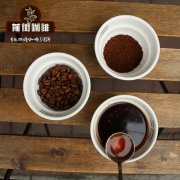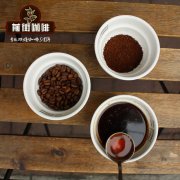La Paz, La Paz District of Honduras | Finca Los Pinoskaduai SHG wind of Old Pine Manor

Professional coffee knowledge exchange more coffee bean information please follow the coffee workshop (Wechat official account cafe_style)
La Paz, La Paz District of Honduras | what is the flavor and cooking of Finca Los Pinoskaduai SHG in Old Pine Manor?
2017 Honduras National Victory-Los Pinoska du Ai, an old pine estate from La Paz, La Paz. Abel Mejia worked with his father at the coffee farm in La Paz when he was a child. After marriage, his father gave him a small farm to support his family. Abemesia was not yet 30 years old, but he found that The best way to increase income to support a small family is to improve the quality of coffee and sell it at a better price! He tried his best to improve the quality, learned to take better care of the fruit trees, inspected and managed the manor, and built a scaffolded tanning house (solar house), because only the quality of the coffee produced was excellent to attract long-term buyers. He was eager to absorb new knowledge and focused on the fact that the quality of coffee could stand out in the highly competitive coffee competition. He did it for the first time in 2017! Won the national competition!
Abemesia's story not only moves you and me, the important thing is that we can experience delicate juices, rich white chocolate, cool mint and elegant and delicate vanilla sweetness from his coffee! Berries, vanilla sweet, mint, white chocolate, juicy feeling
Honduras has always been among the top few in the boutique coffee market, but Honduras has the advantages of natural environment, such as excellent soil quality, altitude and climatic conditions. Nearby Guatemala, El Salvador and Nicaragua also have advanced coffee production. What Honduras lacks is infrastructure and its reputation in the consumer market is not good enough. Hongguo is better known for commercial beans than boutique beans. No matter how good the quality is, there is no way to sell them at a good price. Many beans from Koban and Santa Barbara are mixed with fish eyes as Guatemala beans, and they are sold at the price of Guatemalan beans, and for a long time they are not aware of their own potential for the cultivation of high-quality coffee beans. The main problem is that coffee cherries are only slightly processed. It is sold to the processing plant when it is still wet, which often causes coffee cherries to become moldy and damaged before they are officially dried until the moisture content is only 12%. Such cherries become defective beans after drying. Since there is no relative price return for good quality, coffee farmers, processors and exporters have no incentive or incentive to increase costs to develop the potential for coffee cultivation, so that the end of Honduran coffee beans has become recognized as a mild mixed bean. rather than beans from a single origin or unique farm, this is a vicious circle.
But now it's different, with the help of USAID and Fintrac and several cooperatives like La Central, they try their best to promote and educate Macro bean farmers to produce good coffee, and then properly handle it to maximize the flavor of the final coffee. In addition, the Fair Trade Association (Fair Trade) funded the construction of processing equipment and increased the expertise of coffee farmers to gradually bring Honduran coffee out of the trough. It has become a burgeoning Central American coffee in the past year or two.
Honduras is as diverse as other producing countries, and I can't cover them all in one way. The largest producing area is Santa Barbara Santa Barbara, and there are other producing areas such as Copan Koban, Ocotepeque Ocotepec, Lempira Lompilla, La Paz Baz, and El Paraiso Periso in the south, which are planted at an altitude of 1500 meters to 2000 meters above sea level. Mainly grow extremely high sea beans (SHG) generally speaking, the Honduran coffee we have recently tested has low acidity, high sweetness and obvious caramel flavor, which is an excellent choice for espresso beans.
Production area: La Paz
Altitude: 1650 m
Variety: Kaduai
Processing: Washed
Qianjie coffee brewing is recommended:
Filter cup: Hario V60
Water temperature: 90 degrees
Degree of grinding: small Fuji 3.5
Cooking methods: the ratio of water to powder is 1:15, 15g powder, the first injection of 25g water, 25 s steaming, the second injection to 120g water cut off, waiting for the powder bed water to half and then water injection, slow water injection until 225g water, extraction time about 2:00
Analysis: using three-stage brewing to clarify the flavor of the front, middle and back of the coffee. Because V60 has many ribs and the drainage speed is fast, it can prolong the extraction time when the water is cut off.
Important Notice :
前街咖啡 FrontStreet Coffee has moved to new addredd:
FrontStreet Coffee Address: 315,Donghua East Road,GuangZhou
Tel:020 38364473
- Prev

Orange County in the valley region of western Costa Rica | the flavor of Velassa strange species treated by Yellow Honey of Infinite Manor
Professional coffee knowledge exchange more coffee bean information please follow the coffee workshop (Wechat official account cafe_style) Orange County in the valley region of western Costa Rica | Infinite Manor Yellow Honey deals with the flavor of Verassa strange species? Infinite Manor was founded by Jos Jaime Crdenas Rojas and his two sisters, Maribel Barrantes Ziga and Kattia Barrantes Ziga.
- Next

Nicaragua | Secret Manor Natural decaffeinated Bourbon Laurina species | Honey treated Lot 180
Professional coffee knowledge exchange more coffee bean information please follow the coffee workshop (Wechat official account cafe_style) Nicaragua | Secret Manor Natural decaffeinated pointed bourbon Laurina species | Honey-treated Lot 1802 flavor? Pointed bourbon original Laurina or Bourbon Pointu, her caffeine content is only about 0.6%, normal Arabica
Related
- Detailed explanation of Jadeite planting Land in Panamanian Jadeite Manor introduction to the grading system of Jadeite competitive bidding, Red bid, Green bid and Rose Summer
- Story of Coffee planting in Brenka region of Costa Rica Stonehenge Manor anaerobic heavy honey treatment of flavor mouth
- What's on the barrel of Blue Mountain Coffee beans?
- Can American coffee also pull flowers? How to use hot American style to pull out a good-looking pattern?
- Can you make a cold extract with coffee beans? What is the right proportion for cold-extracted coffee formula?
- Indonesian PWN Gold Mandrine Coffee Origin Features Flavor How to Chong? Mandolin coffee is American.
- A brief introduction to the flavor characteristics of Brazilian yellow bourbon coffee beans
- What is the effect of different water quality on the flavor of cold-extracted coffee? What kind of water is best for brewing coffee?
- Why do you think of Rose Summer whenever you mention Panamanian coffee?
- Introduction to the characteristics of authentic blue mountain coffee bean producing areas? What is the CIB Coffee Authority in Jamaica?

